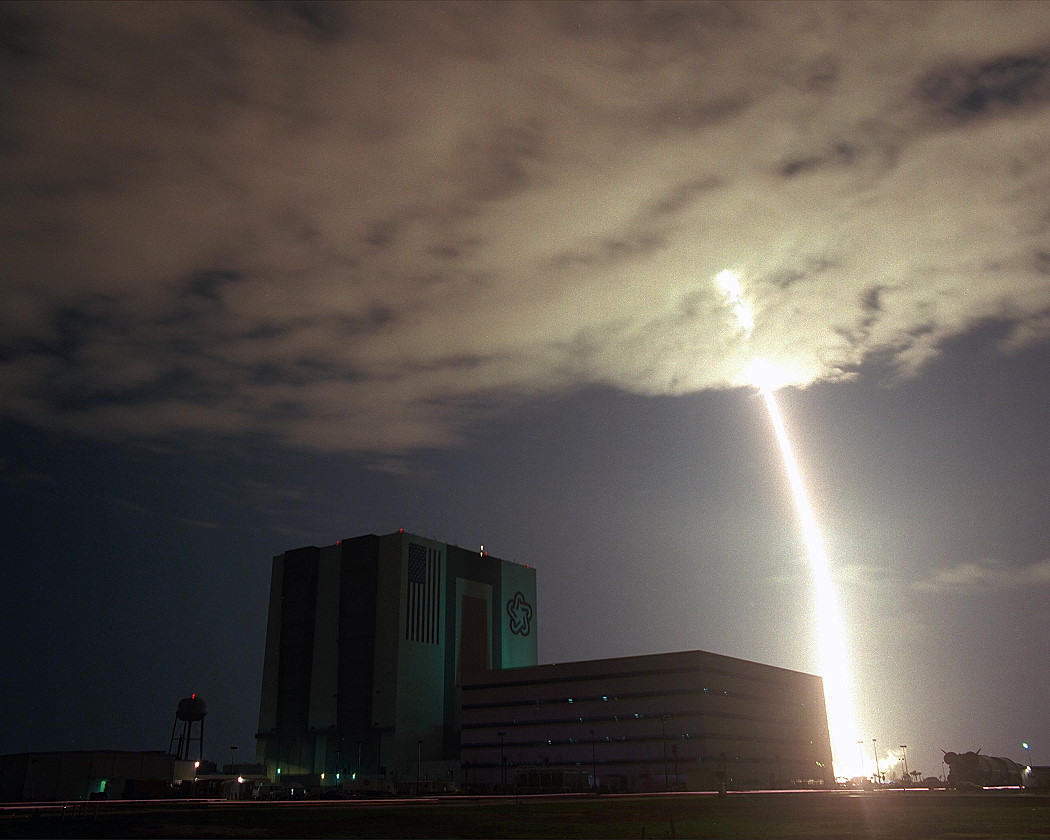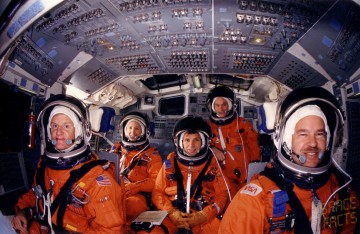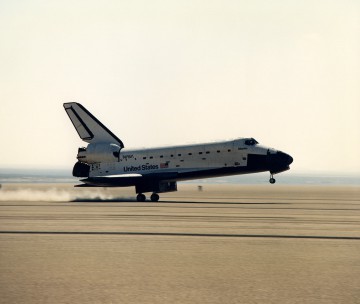
A quarter-century has now passed since one of the quietest missions in the shuttle’s 30-year operational history. On 28 February 1990, the orbiter Atlantis and her STS-36 crew—Commander John “J.O.” Creighton, Pilot John Casper, and Mission Specialists Mike Mullane, Dave Hilmers, and Pierre Thuot—rocketed into orbit for four days of activities on behalf of the Department of Defense. During that short period of time, the astronauts deployed a classified payload, known at the time as Air Force Program (AFP)-731, but more commonly known under the program name of “Misty,” whose nature even today continues to mystify. As described in yesterday’s AmericaSpace history article, Atlantis performed a “dogleg” maneuver during ascent to reach the highest inclination (62 degrees) ever achieved by a U.S. human space mission.
Having said that, Atlantis’ altitude on STS-36 was one of the shuttle’s lowest, often reaching only a little higher than 125 miles (200 km). For Mullane, this presented stunning views of Earth, which made the Home Planet seem “hugely close.” The wind-rippled waves of the oceans were visible in astonishing clarity and, flying over the Caribbean Sea, the humps and valleys of the sea floor stood out in stark relief. Elsewhere, supertankers in the Persian Gulf could be seen, with their V-shaped wakes glinting in the sunlight, whilst further south, ribbons of plankton stretched out to sea on the fringes of Antarctica. On one occasion, Mullane saw a flotilla of icebergs in the Southern Ocean and used gyroscopically stabilized binoculars to take a look at the distant land mass of Antarctica. “The pole was nearly 1,800 miles (2,900 km) distant,” he wrote in Riding Rockets, “so I had no view of it. Instead, I focused on the rugged coastal mountain chains. The occasional black of a windswept cliff was the only color in an otherwise sheet-white topography.”
Floating horizontally, he found that he could roll himself into a ball and plant his face against Atlantis’ forward flight deck windows, which, with the cockpit lights switched off, made it seem as if he were snorkeling in the Aegean Sea, watching the iridescence of sea life through a face mask. Over the Pacific Ocean, as trade winds of the northern and southern hemispheres met and mixed in the heat and humidity of the equator, ominous clouds flickered with electricity—“sputtering fluorescent light bulbs,” Mullane called them—as thunderstorms rippled across the region. He had already decided that STS-36 would be his final mission and was determined to spend this quiet time at the windows on his last full evening in space. Every hour and a half, Atlantis brushed the Arctic and Antarctic Circles and the astonishing diversity of Earth was displayed, map-like, beneath him: the dense Siberian taiga, the rolling dunes of the African deserts, punctuated in their north-eastern corner by the green of the Nile Delta, the snow-capped mountaintops of the Himalaya and the Andes … and, finally, the place he called home: the sprawling city of Albuquerque, N.M. Bordered by the Sandia Mountains to the east and with the mighty Rio Grande flowing through it, from north to south, this was the place to which Mullane and his wife intended to return.

More than two decades later, Atlantis’ flight remains secret, although it is known that AFP-731 was deployed on the second day in orbit. “The payload had been expected to be deployed at 27 hours into the mission,” wrote observer Ted Molczan, based in the Canadian capital, Toronto. However, observations made some 28-31 hours into the mission revealed only the orbiter and, somewhere between 34-35 hours, Atlantis’ orbit changed slightly, providing clear evidence of a separation maneuver from the payload. “Therefore, deployment probably occurred between 31.5 and 35.3 hours,” concluded Molczan. “It is possible that it occurred earlier and that the spacecraft were too close together to separate it with binoculars.” Certainly, the “separation burn” took place on the afternoon of 1 March and the payload was sighted, in an orbit of 154 x 161 miles (248 x 260 km), some 57 seconds in time “behind” Atlantis, on the morning of the 2nd.
Creighton and his crew returned to Earth on 4 March 1990, touching down at Edwards Air Force Base, Calif., at 10:08 a.m. PST. Sketchy details trickled out in the following weeks: that AFP-731 was some sort of electro-optical reconnaissance platform, possibly with a signals intelligence component, and that it utilized a mechanism known as the Stabilized Payload Deployment System (SPDS), which “rolled” it over the shuttle’s payload bay wall and released it in an offset, near-vertical angle of between 65-80 degrees. The SPDS, described in a 1989 paper by Johnson Space Center (JSC) engineers Guy King and Ted Tsai, was an electromechanical structure, capable of rotating the payload longitudinally out of the bay at a pre-determined angular position and separating it on command. Mounted on the port side of the bay, it took the position normally occupied by the Canadian-built Remote Manipulator System (RMS) mechanical arm.
“Two separable hinge-like devices connect at one longitudinal side or edge of the payload to respective ones of the payload trunnions at different longitudinally-spaced locations along the length of the payload,” the NASA Patent Application for SPDS revealed. “Separation of the payload from the bay is made [by] unlatching a latch and by the use of a repulsion spring at the position of each hinge-like device. Two four-link mechanisms allow movement between payload and bay. Such accommodative movement is required, especially duting launch, when considerable vibration is encountered.” One of the key aims of the SPDS was to more safely maneuver a payload away from the shuttle. “It is a feature of the present invention that the payload is safely outside of the bay before it is separated from the shuttle,” the patent application continued. “This makes it possible … to prevent the payload from colliding with the shuttle. The separation … is thus less hazardous.” Having said this, redundancy was provided in the form of a pyrotechnic separation system.

“After the payload is stabilized,” wrote King and Tsai in their paper, “it is released through a double swivel toggle release mechanism, located within the release head.” By the time Atlantis landed, observers had already noticed that the satellite had increased its altitude from 158 miles (254 km) to 168 miles (271 km), and on 7 March 1990 it executed a much larger maneuver. After the sighting of the five mysterious objects in late March, nothing more was seen until mid-October 1990, when a team of European observers tracked something at an altitude of 504 miles (811 km), inclined 65 degrees to the equator.
Although the United Nations had received no notification of anything operating in that region, analysis of AFP-731’s track suggested that it was the closest possible contender, and it was suggested that the “debris” seen in March was actually associated with the transfer of the satellite to its operational orbit. Certainly, this orbit was adjusted again in early November—possibly to monitor the deteriorating situation in the Persian Gulf; Saddam Hussein having invaded Kuwait the previous August—although attempts to “find” it in the weeks which followed were unsuccessful. It has also been suggested that another of AFP-731’s targets were the Soviet Union’s military assets in the Arctic Ocean, particularly the strategic archipelago of Novaya Zemlya.
Over the years, the satellite’s “vanishing trick” was assumed to represent an example of a new-generational spacecraft, capable of demonstrating optical or radar stealth to prevent adversaries from monitoring it or predicting exactly when it would overfly their territories. Not until 1996-97 was AFP-731 seen again by civilian observers, purely by chance, in binoculars, at an inclination of 66.2 degrees and a lower altitude of about 457 miles (736 km), and more recent speculation has been aired that it possessed some form of inflatable “shield,” perhaps conical in shape and composed of very thin polymers, coated with highly reflective gold or aluminum. This shield, it is theorized, was designed to suppress the satellite’s optical or radar signature.
Today, it is often known by the code name of “Misty” and is thought to have been built by Lockheed Martin, specifically as a “low-observable” spacecraft at a unit cost of around $360 million. Its original purpose, according to GlobalSecurity.org, was to permit the United States to catch the Soviets cheating on arms control agreements. A second Misty satellite is believed to have been inserted into orbit in May 1999, and there has been some suspicion that the National Reconnaissance Office’s NROL-15 mission—launched in June 2012—may have been a follow-on member of the same or similar class. However, it is generally assumed that STS-36’s first-generation Misty was probably deorbited sometime after 1997.

Whilst the two Defense Satellite Communications System (DSCS) military communications satellites deployed by the shuttle on Mission 51J in October 1985 were unveiled a little more than a decade after launch, it seems highly unlikely that any concrete facts will be revealed about intelligence platforms like Misty for many years to come. The STS-36 crew had all been subjected to intensive background checks by the intelligence community during the astronaut application process, but flying on a Department of Defense mission required a new level of security clearance. “There was additional background information,” Creighton remembered, “because you were going to be cleared Top Secret for a clearance. Most of the military guys had already had a Top Secret clearance when they were in the military, but it’s only good for specific purposes. I’m sure they did a background check on us before we were announced as a crew, unbeknownst to any of us.”
Creighton’s recollection is that only about two dozen other souls knew exactly what happened for the entirety of STS-36, including NASA Administrator Dick Truly and the mission’s flight directors. “Most of the people in Mission Control didn’t know specifically what we did,” he added. Yet for five military officers—Creighton and Thuot were both Navy, Casper and Mullane were Air Force, and Hilmers was a Marine—the sense of pride at completing a mission for the national security interest was pervasive. “Even though I can’t talk about them,” Mike Mullane said, “I feel very, very proud about those DoD missions. I felt like that was something that had a significant impact on America’s security … and I was part of it.”
This is part of a series of history articles, which will appear each weekend, barring any major news stories. Next week’s article will focus on the 20th anniversary of STS-67, which secured a record in March 1995 for the longest shuttle mission at that time.
Want to keep up-to-date with all things space? Be sure to “Like” AmericaSpace on Facebook and follow us on Twitter: @AmericaSpace




It has been a joyous year in celebrating a couple of great DoD missions flown on Shuttle. At the end of January, we celebrated the 30th anniversary of the first fully classified DoD mission on Shuttle: STS-51C, flown with Hawaiian astronaut Ellison Onizuka.
And now – the 25th anniversary of STS-36. Today, March 4th is the 25th anniversary of the landing of STS-36. Of all the 25 Shuttle flights that I was honored to participate as Flight Director in the Mission Control Center in the 80’s and 90’s, none compared in significance and importance to that of STS-36.
In fact, as recently as the 20th anniversary of STS-36 in an undisclosed location along the east coast, it was viewed by many as one of the most critical and important missions ever flown in the entire Shuttle Program (with the exception of the Hubble mission).
Of the thousands of employees at the NASA Johnson Space Center, literally only a handful were allowed full access to this classified mission….working for 3-1/2 years with a select few from the DoD community in the detail planning and execution of an incredible flight. It was the most highly classified mission we ever planned and flew in the Shuttle Program….extremely tight security!
A sense of the importance its payload is seen in the 62 deg launch inclination. STS-36’s importance led to the only Shuttle flight to develop unique ascent I-Loads at 62 deg inclination for boost phase to get the mission in the best trajectory….no other mission ever flew beyond the standard 57 deg inclination.
Since we can’t talk about the mission itself, this anniversary does bring two memories back to me…one at launch and one at landing.
First, we had shifted our days by 12-hours about a week or two before launch….working from 8pm to 4am. This huge shift caused some of us to get sick leading up to flight…including the crew. It was odd working in the office late at night, 12-hours apart from the rest of the center.
A few days before launch, I flew to the Cape to meet up with the crew and an undisclosed USAF General for a walkdown of the payload bay of Atlantis at 2am in the morning. After passing through what seemed like a hundred security checkpoints on the way to the pad, we finally arrived at the payload changeout room and got into the white smocks. It was very eerie being at that pad that time of night…there was no work ongoing, no technician (except for those in the payload changeout room), yet the Orbiter was powered up and humming with its circ pumps and power systems. Although I had been to the pad many times before, this late-night visit was special…Atlantis bathed in white search lights, humming away with life, ready to fly. But we were unprepared for the beauty nad experience we beheld as we entered the changeout room and looked at the payload bay. Our STS-36 program was amazing and beautiful. We all just stood quietly, no one speaking for about 30 minutes…just taking in the sight and having some personal time with the spacecraft. It prepared us mentally for the complex tasks ahead. Standing there, I have never felt so proud to be an American, of serving in NASA, serving as a flight director, and about to do something of great importance for our nation. We were all filled with pride, honor and humbled respect for our incredible mission ahead. We would never again be this close to the spacecraft that we had worked on for 3-1/2 years.
Launch day, on our 5th attempt, didn’t even seem like it would happen! That night we watch TV images from the launch pad at the Cape…with hard, horizontal rain pouring over the pad and the launch vehicle. Most of us didn’t have much hope that we would launch; but we got a sudden break in the weather and experienced a beautiful night launch right up the east coast of the U.S. at 62 deg inclination. We all felt it was a wonderful start for this mission.
The other memory I had was a story after touchdown. We ended up landing at Edwards dry lake bed on March 4th. Normally, after wheels stop, the KSC convoy team rolls out meet the Orbiter and to get the crew out of the cockpit. While they did hook up the external cooling carts to help cool Atlantis’ avionics, the convoy team was not allowed immediate access to the crew/cockpit. As everyone stood around, a small dust cloud emerged way off across the lakebed…getting bigger and bigger. Soon, you could make out three rapidly approaching vehicles. A black limo with heavily guarded jeeps leading and trailing the limo. All three vehicles quickly come to an abrupt halt in front of the stairs to the whiteroom leading to the cockpit. Heavily armed guard quickly post themselves on either side of the stairs. An officer emerges from the limo, rapidly ascends the stairs and enters the cockpit of Atlantis. After a few minutes, he emerges with a satchel buried in his arms…carrying it like a fullback with both arms across it…holding it against his stomach. These were all the highly classified images and documents from the flight that had to be removed before the KSC convoy team could get close to Atlantis. As they drove off as fast as they had arrived in a cloud of lakebed dust, everyone sat in amazement with their mouths open. They had never experienced anything like this before.
And that is what STS-36 was…and amazing mission, critical to our country. It is still one of the MOST important missions we ever flew in the 130+ Shuttle missions.
A few years ago, I had the privilege of seeing the Shuttle Atlantis at the KSC Visitor Center at the Cape. She hangs there as if flying, her precious cargo bay tilted so you can look in. Standing there looking at Atlantis, I couldn’t help but cry… thinking of the wonderful mission she had flown so proudly for us on STS-36.
God bless all those who worked on Shuttle…and especially today….those who spent 3-4 years of their lives on STS-36.
Rob Kelso
STS-36 Flight Director